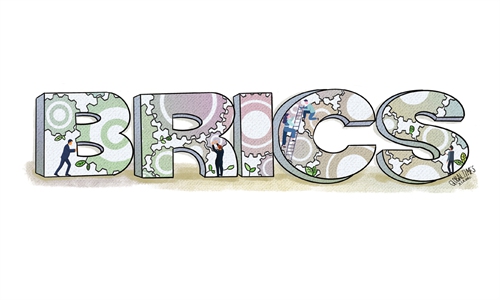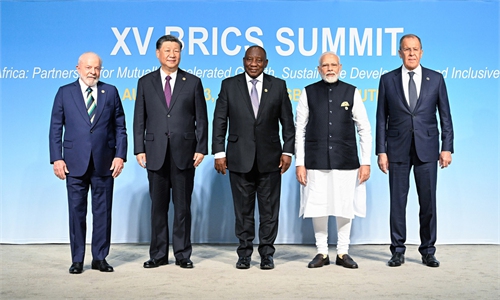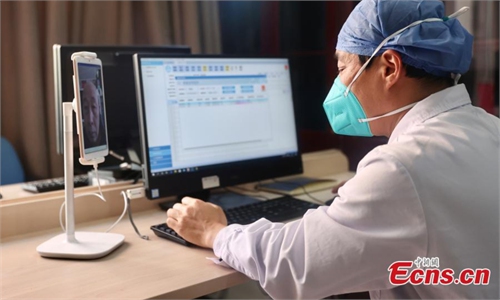Rejecting the US as a guardian! Europe is decoupling itself from US directives!
 The Sandton Convention Centre in Johannesburg, South Africa, where the 2023 BRICS Summit is hosted, August 20, 2023. Photo: IC
The Sandton Convention Centre in Johannesburg, South Africa, where the 2023 BRICS Summit is hosted, August 20, 2023. Photo: ICThe BRICS countries have decided to invite six countries - Argentina, Egypt, Ethiopia, Iran, Saudi Arabia and the United Arab Emirates - to become new members of the grouping, South African President Cyril Ramaphosa said on Thursday. It will be the first expansion since 2010 and the new candidates will be admitted as members on January 1, 2024, according to media reports.
With the expansion of the BRICS topping the agenda of the three-day 15th BRICS summit in Johannesburg, BRICS countries have reached a consensus on guiding principles, standards, criteria and procedures of the grouping's expansion process, South African President Cyril Ramaphosa told a briefing on Thursday.
Chinese President Xi Jinping said at the briefing that the BRICS expansion is historic and a new starting point for BRICS cooperation. It demonstrates the determination of the BRICS countries to unite and cooperate with other developing countries, meets the expectations of the international community, and serves the common interests of emerging markets and developing countries.
The expansion will also inject fresh vitality into the BRICS cooperation mechanism, and further strengthen the forces for world peace and development, Xi said, noting that as long as the BRICS countries pull together, a lot can be achieved in BRICS cooperation, and a promising future awaits the BRICS countries.
The summit also adopted the Johannesburg II Declaration, reaffirming the countries' commitment to the BRICS spirit of mutual respect and understanding, sovereign equality, solidarity, democracy, openness, inclusiveness, strengthened collaboration and consensus. A consensus was reached on partnership for inclusive multilateralism, fostering an environment of peace and development, partnership for mutually accelerated growth, partnership for sustainable development, deepening people-to-people exchanges and institutional development.
The expansion of the BRICS not only demonstrated the vigorous trend of the BRICS mechanism, far exceeding the expectations of some Western countries like the US, but also served as a powerful response to Western-led hegemony, experts said, noting that more developing countries hoping to join the grouping showed the expectations of strengthening their voices and autonomy in global issues, advocating for a more equitable, just, diverse and multi-polar international order.
New members, new momentum
"We are really very happy that this process is accelerating, so I want to thank China and all the BRICS countries for their support," Argentine Ambassador to China Sabino Vaca Narvaja told the Global Times on Thursday.
"Together, we are going to represent the voice of emerging countries, which have historically been neglected in international organizations," Narvaja said.
"The strengthening of the BRICS is essential for the development of the countries of the Global South. I believe that this space represents countries that have the same problems and the same needs, which is why it will be easier to work together to strengthen our development," the Argentine envoy said.
"Expanding this scope is key to building a more harmonious global order where cooperation replaces confrontation; productive development, to financial speculation; the principle of mutual respect, to unilateral interventionism; economic integration, instead of anachronistic sanctions; and the transfer of technology, replacing technological blockades," he said.
Some experts believed that the new members all play important geopolitical roles in different regions, representing emerging economies among developing countries, considering their GDP scales and potential future growth.
"This is a major step forward for the BRICS family, as we will expect a stronger BRICS voice to be heard in global governance, playing an important role for international relations to become more democratic, just and reasonable," Wang Youming, director of the Institute of Developing Countries at the China Institute of International Studies in Beijing, told the Global Times on Thursday.
An expansion of the group of emerging market powers could help boost its global heft and counter the dominance of the G7, Bloomberg said. The enlargement will see BRICS' gross domestic product rise to 36 percent of global GDP at purchasing power parity and 46 percent of the world's population, US media reported, citing Brazilian President Luiz Inacio Lula da Silva.
Egypt is eager to join the BRICS group of nations with the aim of reforming the global economy for greater fairness in the face of ongoing world fluctuations and economic crises, Hassan Rajab, professor at the Suez Canal University in Egypt, told the Global Times.
He also believes that over time, countries within the BRICS group, including Egypt, will be able to boost their own currency, the Egyptian Pound, thereby easing the pressure of the US dollar.
"Egypt is a member of African trade associations such as the Common Market for Eastern and Southern Africa (COMESA), which facilitates the entry of Egyptian products and goods produced in Egypt into the markets of these nations. This provides a convenient gateway for Egyptian investments, offering a significant advantage," Rajab said.
"Through collaboration with Egypt, BRICS countries can further deepen their partnerships with Arab and African nations. This collaboration seeks to foster increased economic cooperation and development," he said.
De-dollarization
Besides BRICS expansion, reducing the dependence on the US dollar has also been the focus of the summit, especially after Russian President Vladimir Putin criticized Western sanctions in an address on Tuesday, saying "de-dollarization" is an "irreversible" process and "is gaining pace."
Leaders of the BRICS countries have tasked their countries' finance ministries and central banks with considering the possibility of launching national currencies-based payment instruments and platforms, Ramaphosa said on Thursday.
Also, the leaders stressed the importance of encouraging the use of local currencies in international trade and financial transactions between BRICS as well as their trading partners, and encouraging the strengthening of correspondent banking networks between BRICS countries and enabling settlements in local currencies, according to the declaration.
Experts believed that when major oil producers such as Saudi Arabia and Iran join the BRICS, the oil trade will easily "undergo de-dollarization," something the West is worried about.
"The US should not be allowed to use the dollar to put pressure on other countries," Professor Mohammad Marandi, Vice President of the University of Tehran, told the Global Times in a previous interview.
Iran already sells a substantial amount of petroleum using currencies other than the US dollar. "I think for Saudi Arabia, ultimately it will be in its best interests to move away from the dollar as well, in order to make sure that it is not vulnerable or less vulnerable to the US," he said.
West underestimates BRICS' resolve for solidarity, cooperation: Global Times editorial
As long as the spirit of BRICS is upheld, opportunities for cooperation and progress can be found everywhere. As more like-minded developing countries join BRICS, a stronger collective force will form, emitting a more resounding "BRICS voice," driving the world toward good governance.
RELATED ARTICLES
Countries look to the BRICS as a source of new ways to establish partnerships and support economic and social development.












